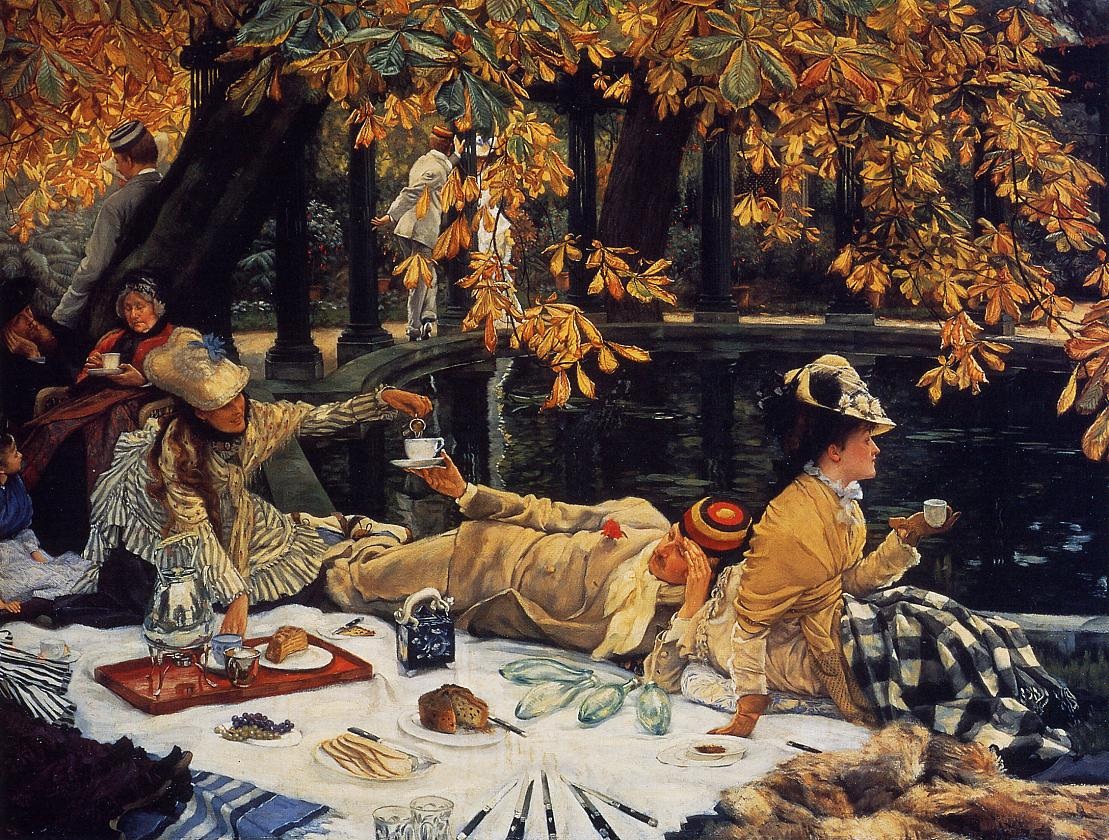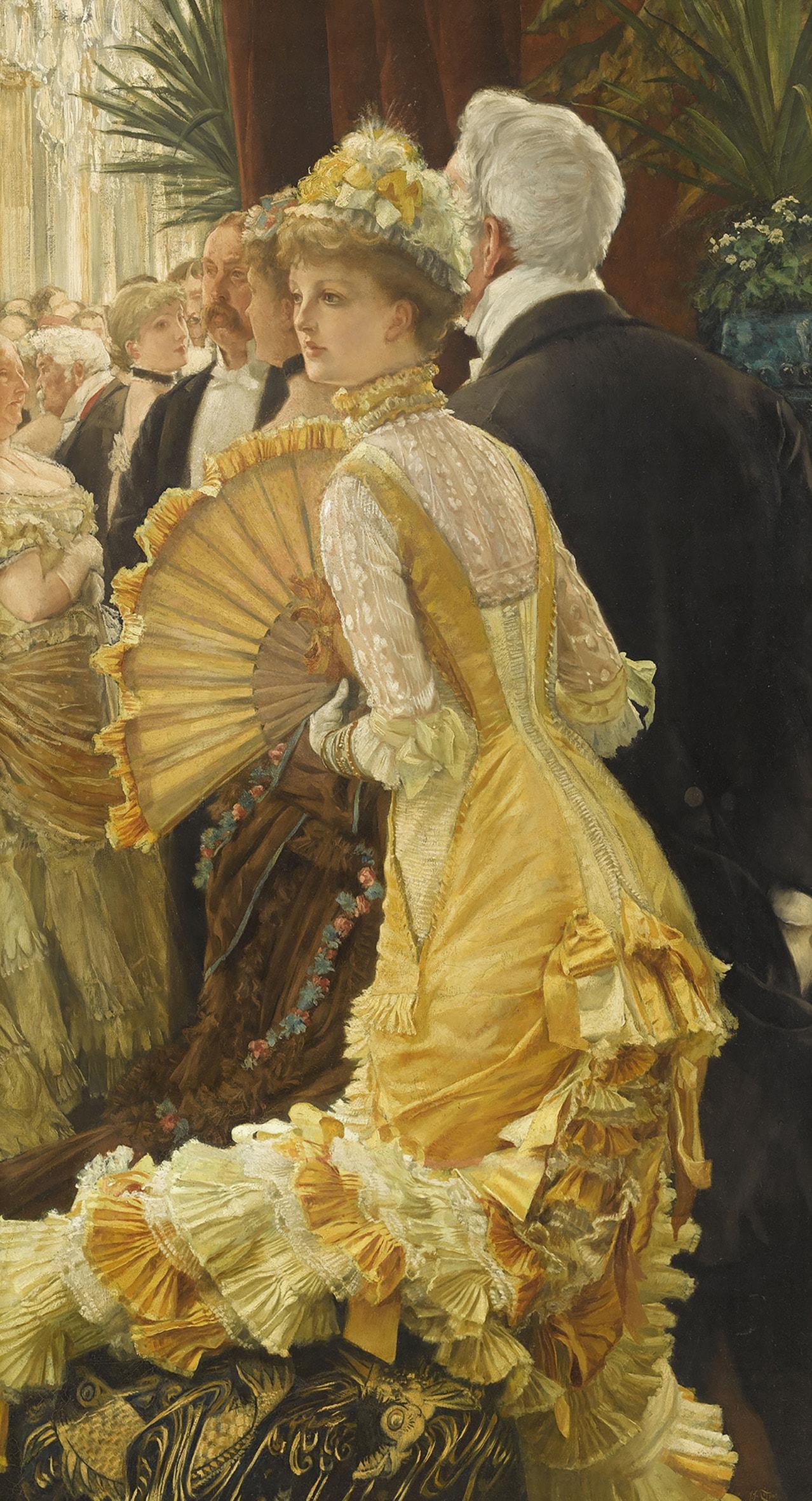Since 2000, museums have acquired seven more oil paintings by James Tissot. As of January, 2015, there now are seventy-eight oil paintings by James Tissot in public art collections worldwide: twenty-three in the U.K., two in the Republic of Ireland, seventeen in France, twenty-four in the U.S. and one in Puerto Rico, six in Canada, one in India, two in New Zealand, and two in Australia.

View of the Garden at 17 Grove End Road (c. 1882), by James Tissot. Oil on canvas, 27 by 21 cm. Geffrye Museum of the Home, London. Courtesy http://www.jamestissot.org
Previously in a private collection, Tissot’s View of the Garden at 17 Grove End Road (c. 1882) was sold to Agnew’s by Sotheby’s, London in 2000 for $14,215 USD/£ 10,000 GBP (Hammer price). In 2004, the Geffrye Museum of the Home in London purchased the painting from Agnew’s for £21,000, with assistance from The Art Fund, the MLA/V&A Purchase Grant Fund and The Friends of the Geffrye Museum. View of the Garden at 17 Grove End Road was exhibited at the Cecil Higgins Art Gallery, Bedford, in J J Tissot and his London Circle, October 2002 through January 2003, and at the Geffrye Museum in Home and Garden Part Two, 1830-1914, March 9 to July 18, 2004. The painting is on exhibit in the Geffrye’s permanent display of eighteenth and nineteenth century paintings of domestic spaces in the Reading Room.

En plein soleil (In the Sunshine, c. 1881), by James Tissot. Oil on wood, 9 3/4 by 13 7/8 in. (24.8 by 35.2 cm). Metropolitan Museum of Art, New York. (Photo: Wikiart.org)
En plein soleil (c. 1881), which depicts Tissot’s young mistress and muse, Kathleen Newton (1854–1882) in the lower left hand corner, was painted in the garden of his large home at 44, Grove End Road, St. John’s Wood, London. En plein soleil was with Lenz Fine Arts, Milwaukee, Wisconsin, U.S.A. until 1976, when it was sold to Williams and Son, London. That firm sold the painting to Stair Sainty Gallery, London, from which it was purchased in 1976 by the Marquess of Bristol, London. In 1983, the Marquess sold it back to Stair Sainty, where it was purchased that year by retired oil executive Charles B. Wrightsman (1895–1986) and his wife, the socialite, philanthropist and fine arts collector Mrs. Jayne Wrightsman (b. 1919), of New York. After Mr. Wrightsman’s death, Mrs. Wrightsman kept the picture until 2006, when she gifted it to the Met. It is not currently on view, but click this link to see an interactive image of it.

The Marquis and the Marquise de Miramon and their Children (1865), by James Tissot. Oil on canvas, 69 11/16 by 85 7/16 in. (177 by 217 cm). Musée d’Orsay, Paris. (Photo: Wikimedia.org)
In 1865, Tissot had found an entrée to the French aristocracy when he was commissioned to paint The Marquis and the Marquise de Miramon and their children [René de Cassagne de Beaufort, marquis de Miramon (1835–1882), his wife, née Thérèse Feuillant (1836–1912), and their first two children, Geneviève and Léon, on the terrace of the château de Paulhac in Auvergne]. Tissot depicted them outdoors, as an informal, affectionate family. The Marquis and the Marquise de Miramon and their children served as Tissot’s calling card to the lucrative market for Society portraiture when it was exhibited in Paris, at the Cercle de l’Union Artistique, in 1866. The portrait remained in the family until 2006, when it was acquired by the Musée d’Orsay; the first time it had been exhibited anywhere else since 1866 was with the blockbuster exhibition, Impressionism, Fashion, and Modernity. Click this link to an interactive image for a closer look.

Portrait of the Marquise de Miramon, née, Thérèse Feuillant (1866), by James Tissot. Oil on canvas, 50 1/2 by 30 3/8 in. (128.3 by 77.2 cm). The J. Paul Getty Museum, Los Angeles, California. Digital image courtesy of the Getty’s Open Content Program.
The J. Paul Getty Museum, in Los Angeles, California, acquired the stunning Portrait of the Marquise de Miramon, née, Thérèse Feuillant (1866) from the family in 2007. Thérèse-Stephanie-Sophie Feuillant (1836–1912) was from a wealthy bourgeois family. She inherited a fortune from her father, and in 1860, she married Réne de Cassagnes de Beaufort, Marquis de Miramon. Tissot depicts the 30-year-old Marquise in her husband’s castle, the château de Paulhac in Auvergne, wearing a pink velvet peignoir and leaning on the mantel in her sitting room with a stylish Japanese screen behind her.
Alongside this portrait at the Getty is displayed a sample of the pink silk velvet used in the Marquise’s peignoir, produced with a modern aniline dye. Her descendants kept this piece of fabric, as well as the letter that Tissot wrote to her husband, who had commissioned the portrait, asking permission to display it at the 1867 Paris International Exhibition. Permission was granted, and this private image was seen by the public for the first time – the only time, until the Getty purchased it.
I saw this painting in May, 2013, when it was on display at the Metropolitan Museum of Art with Impressionism, Fashion, and Modernity. It’s gorgeous – the photograph doesn’t do it justice. It’s currently on view at the Getty, but if you can’t get there, click this link to an interactive image for a closer look.
 Admiring a Portfolio (c. 1883, pastel on linen, 23½ by 29 in. (59.7 by 73.7 cm) features a woman who modelled for Tissot on other occasions, and this picture could have been a means of attracting new commissions. It was sold in Sevres, France, around 1900, then at Sotheby’s, London in 1994 to a private collector in California. In 2008, it was sold at Christies, New York for $104,500 to the Bruce Museum in Greenwich, Connecticut, where it currently is on display behind the front desk in the lobby.
Admiring a Portfolio (c. 1883, pastel on linen, 23½ by 29 in. (59.7 by 73.7 cm) features a woman who modelled for Tissot on other occasions, and this picture could have been a means of attracting new commissions. It was sold in Sevres, France, around 1900, then at Sotheby’s, London in 1994 to a private collector in California. In 2008, it was sold at Christies, New York for $104,500 to the Bruce Museum in Greenwich, Connecticut, where it currently is on display behind the front desk in the lobby.
Spring Morning (c. 1875) oil on canvas, 22 by 16 3/4 in. (55.9 by 42.5 cm), was in the possession of Thomas McLean, London, until about 1901; at some point after that, it was with Goupil, London. It was sold by Sotheby’s Belgravia, London, in 1981, as Matinée de printemps, for £40,000 to Mr. and Mrs. Charles Wrightsman, New York. Mrs. Wrightsman gifted it to the Met in 2009. It is not currently on view, but click this link to see an interactive image of it.

In the Conservatory (The Rivals, c. 1875-1876), by James Tissot. Oil on canvas, 15 1/8 by 20 1/8 in. (38.4 by 51.1 cm). Private Collection. (Photo: Wikimedia.org)
Incidentally, the Met owned a fourth Tissot oil painting, described as a “masterpiece:” In the Conservatory (Rivals), c. 1875. Mrs. Wrightsman gifted it to the Met in 2009, and it was not displayed; the last time it had been exhibited was in the U.K. in 1955. It was deaccessioned on October 28, 2013, at Christie’s, New York, where it sold for $2,045,000 USD/£ 1,270,817 GBP (price includes Buyer’s Premium). Read about this quick passage from museum storage to auction house at For sale: In the Conservatory (Rivals), c. 1875, by James Tissot.

The Circle of the Rue Royale (1868), by James Tissot. 68 7/8 by 110 5/8 in. (175 by 281 cm). Musée d’Orsay, Paris. (Photo credit: Wikimedia.org)
In 1868, most likely due to his portraits of the Marquis de Miramon and his wife and family in 1865 and 1866, Tissot was commissioned to paint the most lucrative and elaborate painting of his career, a group portrait of the twelve members of The Circle of the Rue Royale. Members of the exclusive club, founded in 1852, each paid Tissot a sitting fee of 1,000 francs. He portrayed them on a balcony of the Hôtel de Coislin overlooking the Place de la Concorde in Paris (if you look closely at the original painting, you can see the horse traffic through the balustrade). From left to right: Count Alfred de La Tour Maubourg (1834-1891), Marquis Alfred du Lau d’Allemans (1833-1919), Count Étienne de Ganay (1833-1903), Captain Coleraine Vansittart (1833-1886), Marquis René de Miramon (1835-1882), Count Julien de Rochechouart (1828-1897), Baron Rodolphe Hottinguer (1835-1920; he kept the painting according to the agreed-upon drawing of lots), Marquis Charles-Alexandre de Ganay (1803-1881), Baron Gaston de Saint-Maurice (1831-1905), Prince Edmond de Polignac (1834-1901), Marquis Gaston de Galliffet (1830-1909) and Charles Haas (1833-1902). The members decided who would own the painting through a drawing. The winner was Baron Hottinger, seated to the right of the sofa. The Musée d’Orsay acquired The Circle of the Rue Royale in 2011 from Baron Hottinguer’s descendants for about 4 million euros. It also was included with Impressionism, Fashion, and Modernity, and it drew crowds.
Which of Tissot’s other oil paintings, now in private hands, will be acquired by public collections in the future?
 Tissot’s Young Ladies Admiring Japanese Objects (1869) has been on loan to the Getty Museum from a private collection since about 2012.
Tissot’s Young Ladies Admiring Japanese Objects (1869) has been on loan to the Getty Museum from a private collection since about 2012.
Juan Antonio Pérez Simón (b. 1941) is a Spanish telecommunications billionaire and naturalized Mexican citizen who has the largest private art collection in the world. He began collecting in his early 20s, and he now owns over 3,000 paintings representing artists from fourteenth-century Italy and the German Renaissance to El Greco, Rubens, Canaletto, Goya, Pissarro, Monet, Renoir, Van Gogh, Gauguin, Cézanne, and Dalí.
 Many of the paintings normally hang in Pérez Simón’s six homes, but he plans to leave them to a museum to be built in Mexico City. His collection, also the largest private collection of Victorian art outside Great Britain, includes James Tissot’s Spring (c. 1878), another depiction of Kathleen Newton.
Many of the paintings normally hang in Pérez Simón’s six homes, but he plans to leave them to a museum to be built in Mexico City. His collection, also the largest private collection of Victorian art outside Great Britain, includes James Tissot’s Spring (c. 1878), another depiction of Kathleen Newton.
Award-winning musical theater composer Andrew Lloyd Webber (b. 1948) began to collect Victorian and Pre-Raphaelite paintings as he achieved success with his musicals, Evita (1976), Cats (1981), Phantom of the Opera (1986) and Sunset Boulevard (1993). His collection, now one of the world’s largest in private hands, includes several works by James Tissot from the artist’s London period, 1871-1882, all purchased in the 1990s. In fact, Lloyd Webber owns more Tissot oils than the Tate Gallery in London, and he has said, “I hope that after my death my family will be able to find a way to exhibit the best of my collection on a more permanent basis.”
We hope for a long life for Lord Lord-Webber, a smooth construction for Pérez Simón’s museum in Mexico City, an extended loan period for the Getty’s Young Ladies, and for many philanthropic art collectors to gift their Tissot oil paintings to museums around the world in the coming years.
© 2015 by Lucy Paquette. All rights reserved.
Related posts:
A spotlight on Tissot at the Met’s “Impressionism, Fashion, and Modernity”
For sale: In the Conservatory (Rivals), c. 1875, by James Tissot
James Tissot in the Andrew Lloyd Webber Collection
Tissot in the new millenium: Museum Exhibitions
 If you do not have a Kindle e-reader, you may download free Kindle reading apps for PCs, Smartphones, tablets, and the Kindle Cloud Reader to read The Hammock: A novel based on the true story of French painter James Tissot. Read reviews.
If you do not have a Kindle e-reader, you may download free Kindle reading apps for PCs, Smartphones, tablets, and the Kindle Cloud Reader to read The Hammock: A novel based on the true story of French painter James Tissot. Read reviews.
The Hammock: A novel based on the true story of French painter James Tissot, brings Tissot’s world from 1870 to 1879 alive in a story of war, art, Society glamour, love, scandal, and tragedy.
Illustrated with 17 stunning, high-resolution fine art images in full color
Courtesy of The Bridgeman Art Library
(295 pages; ISBN (ePub): 978-0-615-68267-9). See http://www.amazon.com/dp/B009P5RY



.jpg)


















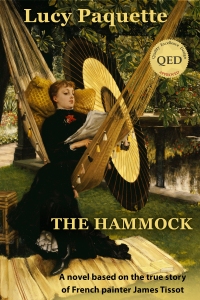












.jpg)



























































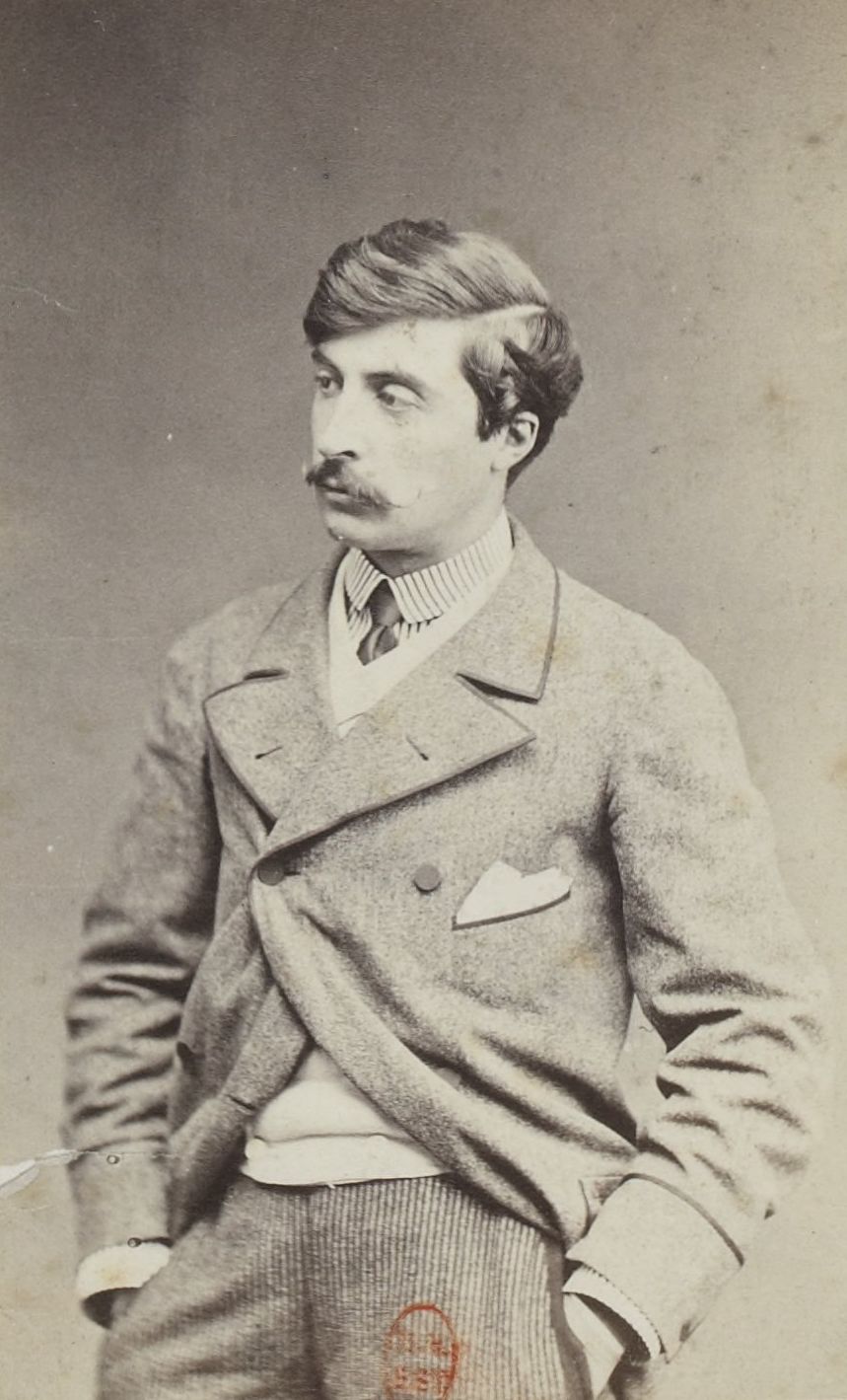


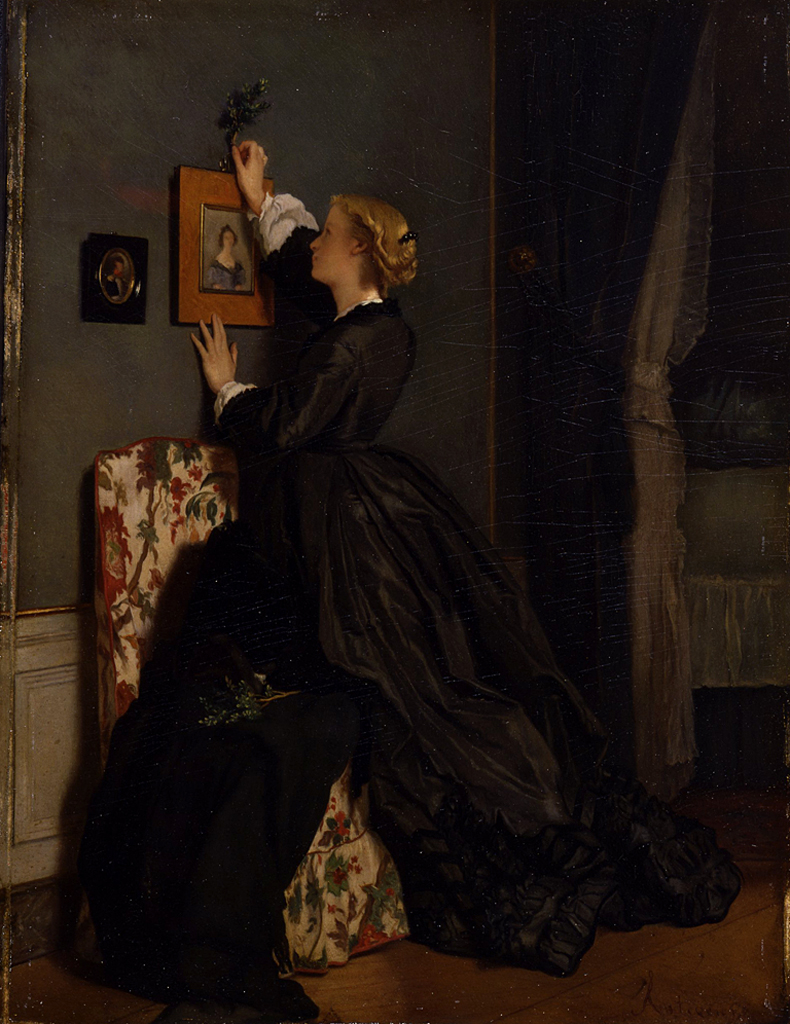








.jpg)










